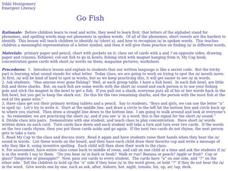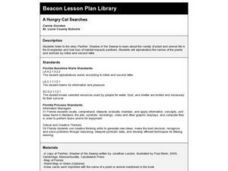Curated OER
The Summer Sun is Hot, Hot, Hot
Students recognize the short vowel o in written and spoken language. Through listening and matching activities, they discriminate the short vowel /o/ from other vowel phonemes. Students associate /o/ with its letter representation and...
Curated OER
The Icky-Sticky Sound
Students recognize the short vowel i in written and spoken language. Through listening activities, they discriminate the vowel sound /i/ from other phonemes. Students associate the phoneme with its letter representation and identify the...
Curated OER
Creaky Door E
Students recognize the short vowel "E" in written and spoken language. Through matching activities, they discriminate the short vowel /e/ from other phonemes. Students associate the phoneme with its letter representation and fill in the...
Curated OER
Appetizing Apples
Pupils recognize the short vowel a in written and spoken language. Through matching activities, students discriminate the short vowel a from the long vowel a. They associate the phoneme with its letter representation and identify the...
Curated OER
Go Fish
Students recognize the short vowel a in written and spoken language. Through matching activities, they discriminate the short vowel /a/ from other vowel phonemes. Students associate the phoneme with its letter representation in a story...
Curated OER
Rub Those Eyes
Learners recognize the short vowel a in written and spoken language. Through matching activities, they discriminate the short vowel /a/ from other phonemes. Students associate the phoneme with its letter representation in words pictures,...
Curated OER
Gulp!
Young scholars identify the grapheme and phoneme for G. They practice writing the letter G and through listening activities, discriminate the phoneme /g/. They associate the phoneme /g/ with its letter representation and identify it in...
Curated OER
The Crying Baby Sound
Students recognize the short vowel a in spoken language. Through matching activities, they discriminate the short vowel /a/ in words and sentences. Students associate the phoneme with its letter representation and read sentences...
Curated OER
4th of July Worksheet - Fill in the Vowels
In this vowels worksheet, students look at 8 pictures and words associated with the 4th of July and fill in the missing vowels in each word. A good, basic letter and sound recognition worksheet.
Curated OER
Word Processing With Pizazz
Students use a word processor and some of its tools to create an exciting and visual autobiography. They download a sample letter and then create one of their own.
Curated OER
Names Count!
Second graders work in small groups to complete a graph and use data to determine range, mode, and median. They use the number of letters in their names and in fairy tale characters names to produce their data. This is a fun lesson!
Curated OER
Name That Sound
Students begin to demonstrate beginning reading strategies. In this technology lesson plan, students match the correct beginning letter and letter sound to a variety of pictures created in a "Kid Pix" template.
Curated OER
Dr. Seuss's ABC Activity Card
In this ABC's worksheet, learners cut out six pictures of characters from Dr. Seuss books. Students paste the pictures in boxes with corresponding first letters.
Curated OER
To Your Health
Students focus on how storks and other cultural icons, in both Bulgarian and American customs, are believed to encourage and bring good health. They list three natural phenomena in their region prominently associated with the coming of...
Curated OER
Agents of Erosion and Deposition
In this science worksheet, students play a game of shoreline charades using picture symbols and other games to cover the concept of erosion or deposition.
Curated OER
Stars and Constellations-Pattern Recognition
In this stars and constellations instructional activity, students study a given constellation and identify the stars in the constellation. They label the stars in the constellation and identify the months the constellation is visible....
Curated OER
A Hungry Cat Searches
Students listen to story Panther: Shadow of the Swamp, and examine how loss of habitat impacts panthers in the Everglades; students alphabetize names of plants and animals found in the Everglades by initial and second letter.
Curated OER
Can Girls Be Plumbers? And Other Gender Stereotypes
Students realize the effects of stereotypes by collaboratively creating a chart with the rest of their class. In this equality activity, students demonstrate stereotypes by collaborating on a jobs chart and matching pictures of people...
Curated OER
Symmetry and Symbols
Students identify symmetrical and congruent elements in folk art. In this art and geometry instructional activity, students examine pictures of Masonic Plaque in the Form of a Royal Arch Tracing Board for evidence of congruent and...
Curated OER
Why do People Migrate?
Second graders examine the reasons for human migration. In this human migration lesson, 2nd graders make lists of reasons why people migrate. Students view pictures of people who have migrated and discuss why. Then the students watch a...
Curated OER
Adjectives
In this adjectives learning exercise, 3rd graders, working in groups of two or three, utilize a cats poster to explore the world of adjectives. Students study the poster and answer twenty-five questions associated with adjectives.
Curated OER
English Exercises - Quantifiers
In this use of quantifiers online worksheet, 4th graders fill in 6 blanks associated with clip art pictures using either "a" or "an." They fill in 18 blanks with "some" or "any" to complete sentences. They use "how much" or "how many" to...
Curated OER
Growth of a River
Students evaluate geography by drawing an image in class. In this river lesson, students identify a list of vocabulary terms associated with bodies of water. Students identify how a river is formed and draw a picture of one including the...
Curated OER
What is a Hero? Heroism in Greek Mythology
Students explore the tales of Greek mythology and discuss what it means to be a hero. They associate acts of epic heroism with philanthropy noting that these characters acted in a larger than life manner to secure the common good.

























